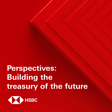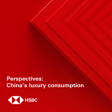Introduction to HSBC Talks Business Podcast
00:00:00
Speaker
Welcome to HSBC Talks Business, the podcast series that brings together business leaders and industry experts to explore the latest global insights, trends, and opportunities.
00:00:11
Speaker
Make sure you're subscribed to stay up to date with new episodes.
00:00:14
Speaker
Thanks for listening.
00:00:15
Speaker
And now onto today's show.
Greener Growth in Real Estate by Gavriela Tenhard
00:00:23
Speaker
I'm Gavriela Tenhard, the Global Head of Market and Strategic Insights at HSPC Markets and Security Services.
00:00:30
Speaker
And I will be hosting our discussion today on building for greener growth as part of our Transition Pathways series.
00:00:38
Speaker
When it comes to reducing the carbon footprint of real estate, policymakers and regulators have traditionally focused on cutting down operational emissions, those that are produced by the in-use operation of buildings from their heating, cooling, and other uses of energy.
00:00:55
Speaker
But the emissions generated by the materials and processes used in the building or demolition of property, what are known as embodied carbon, are rising up the industry agenda.
00:01:07
Speaker
Construction is, after all, a capital-intensive activity, and it is facing tighter environmental standards, which means higher costs.
00:01:16
Speaker
Modern designs and advances in construction practices can help property developers reduce embodied carbon and create more sustainable projects.
Sustainability Experts Introduction: Johnny Yu, Kevin N, Stephen Brownlee Jackson
00:01:27
Speaker
In today's podcasts, we will explore the impact of design and materials on the carbon footprint of the real estate sector.
00:01:35
Speaker
We will take a deep dive into cutting edge practices and consider the economics behind green buildings.
00:01:43
Speaker
To cover this topic, we are delighted to welcome Johnny Yu, Head of Sustainability, Henderson Land Development Company Limited, Kevin N, Senior Deputy General Manager and Project Lead on the Henderson Building, Henderson Land Development Company Limited, and Steven Brownlee Jackson, HSBC's Global Head of Real Estate Research.
00:02:08
Speaker
Henderson Land is one of the leading real estate developers based in Hong Kong, with a large and diverse range of properties across China.
00:02:16
Speaker
It is constructing a new building, the Henderson, in Hong Kong's Central District, a flagship project we will discuss today.
00:02:23
Speaker
So let's start with getting a feel for how environmental standards are rising for new real estate construction globally.
Global CO2 Emissions and Real Estate's Role
00:02:30
Speaker
Stephen, what are you seeing across various markets globally, and what are the implications for investors and developers?
00:02:38
Speaker
Thank you, Gabriella.
00:02:39
Speaker
I think perhaps just to set the scene, it's pretty well documented that approximately 40% of global CO2 emissions come from the real estate sector, of which about 70% is produced by building operations and the remaining 30% from construction.
00:02:57
Speaker
So I think there's no doubt that the link between the real estate sector and the environment is undeniably a strong one.
00:03:04
Speaker
And hence the increase in initiatives from government-led intervention and public and private capital markets has brought about a much-needed level of accountability.
00:03:15
Speaker
And this in turn has raised the bar, which in doing so has also increased standards.
00:03:21
Speaker
I think a good starting point is probably to cite the World Green Building Council.
00:03:26
Speaker
It's the largest and arguably most influential global body
00:03:30
Speaker
which is leading the transformation to sustainable and decarbonised built environments.
Net Zero Goals for Real Estate by 2050 - Are We On Track?
00:03:35
Speaker
It was officially launched in 2018, and the WGBC set out a plan for real estate companies globally to achieve net zero carbon footprints within their portfolios by 2050.
00:03:48
Speaker
I think the good thing now is that there are well over a thousand real estate companies that have signed up to formulating a working plan to achieve net zero.
00:03:58
Speaker
But unfortunately, the slightly more alarming data point is that less than 1% of buildings worldwide are currently net zero carbon.
00:04:07
Speaker
But with increasing urbanisation occurring across the planet, there's a big opportunity to build more environmentally friendly buildings and indeed infrastructure.
00:04:16
Speaker
And some research bodies estimate that 75% of the infrastructure needed by 2050 to support greater urbanisation is still yet to be built.
Sustainability Reporting Standards and Accountability
00:04:27
Speaker
I think also, and importantly for this topic within the context of public capital markets, which by their very nature include many of the world's largest real estate companies, one of course being Henderson Land, the European Public Real Estate Association, EPRA, in conduction with the US body NARIT, the National Association of Real Estate Investment Trusts, launched way back in 2011 its EPRA Sustainability Best Practices Recommendations Reporting Standards.
00:04:55
Speaker
So these aim to ensure that real estate companies report their sustainability-driven activities within a comparable framework, which enables investors to more easily compare between companies, score these companies against their progress, and importantly, deliverability, which in turn has led to the realignment KPIs to include sustainability targets and outcomes within the C-suite remuneration, which I think is a win-win outcome.
Changing Carbon Standards in Asia
00:05:24
Speaker
And then, of course, for investors specifically, the European Union Sustainable Financial Disclosure Regulation, the SFDR, which came into effect in 2021, now requires all investment fund managers to disclose how sustainability risks are integrated into their investment decisions for all funds that they manage.
00:05:44
Speaker
as well as the likely impact of sustainability risks on returns.
00:05:50
Speaker
So I think the above examples of overarching frameworks provide investors with better clarity, measurement and insight into the real estate company's environmental credentials and importantly, a direct link through to KPIs, particularly for the incentivisation of management to deliver on these credentials.
00:06:10
Speaker
Without doubt, these frameworks have provided the impetus to increase standards.
00:06:15
Speaker
That's really interesting, Stephen, and you give a great global overview.
00:06:19
Speaker
Now I'd like to focus on Asia.
00:06:21
Speaker
Johnny, what environmental standards are changing in Asia?
00:06:25
Speaker
And are there any implications of these trends for Henderson lands business?
Henderson Land's Sustainability Strategy
00:06:31
Speaker
Thank you for inviting me to come along.
00:06:33
Speaker
Apart from being the advisor to chairman at Henderson Land, I also focus on sustainability.
00:06:38
Speaker
So at the moment, I'm heading up all the initiatives relating to sustainability at Henderson Land.
00:06:45
Speaker
Regarding your question, Gabriella, there are various environmental standards that are changing in Asia, reflecting the growing concern in this area.
00:06:53
Speaker
And as you know, many Asian countries have already committed to reduce carbon emissions following the Paris Agreement.
00:07:00
Speaker
You know, there are also a lot of Asian countries that are shifting our focus towards renewable energy and also have set more stringent energy efficiency standards.
00:07:10
Speaker
And apart from the energy side, you know, there are also a lot of standards relating to water quality, waste management, such as recycling activities, and also, you know, tighter standard on air quality as well.
00:07:22
Speaker
If you were to look at the key focus recently, everybody has been talking about climate change and extreme weather.
00:07:29
Speaker
And especially investors are more demanding nowadays, expecting more and more disclosure on this front.
00:07:36
Speaker
And hence, International Sustainability Standard Board has recently published two new accounting standards, S1 and S2, relating to sustainability and climate-related disclosure.
00:07:47
Speaker
You know, this is a good thing for investors and for company as a whole, because, you know, they are going to have more informed decision on sustainability.
00:07:56
Speaker
And I think the new accounting standard will help investors to make more and better decisions.
00:08:01
Speaker
That's really interesting, Johnny.
00:08:03
Speaker
And you briefly mentioned sustainability and ESG, but I'd like to understand how specifically Henderson has an outline for the sort of sustainability and ESG strategy in place and particularly for your new construction projects.
00:08:19
Speaker
Yes, at Henderson Land, you know, we always incorporate our sustainability strategies into our day-to-day operations to address three main areas.
00:08:28
Speaker
The first one I mentioned earlier, which is climate risk and also extreme weather.
00:08:33
Speaker
The second one is, you know, how do we
00:08:35
Speaker
promote wellness issues and healthier living and so on.
00:08:39
Speaker
And third one is how do we promote a sustainable community?
00:08:42
Speaker
And of course, in order to achieve this, you know, we have to have a very, very clear strategy in place.
00:08:47
Speaker
And the strategy that we have is very easy to remember.
00:08:50
Speaker
It's called GIVE, G-I-V-E.
00:08:52
Speaker
So G stands for green, green for planet.
00:08:55
Speaker
The idea is, you know, how do we reduce our impact to the environment?
00:08:58
Speaker
And that's why over the, you know, the last 10 to 20 years, you know, we have been working on a lot of green and healthy certs, you know, such as BIM+, LEED, and Well, and so on.
00:09:08
Speaker
So in Hong Kong, we have over 100 green and health certs altogether.
00:09:14
Speaker
And secondly, you know, our strategy is I, I for innovation, innovation for future.
00:09:18
Speaker
The idea is to make use of technology innovations such as robots and also technology to optimize energy usage and so on.
00:09:26
Speaker
But apart from technology innovation, we also focus on social innovation.
00:09:31
Speaker
What I mean by social innovation is that if you were to look at Henderson Land, we
00:09:35
Speaker
work on a lot of urban renewal projects and we have to constantly challenge the existing conventions and innovate in the way that we build, we design so that we can enhance the quality of living.
00:09:46
Speaker
And finally, value for people and endeavour for community are the other two strategies that we will include in every single project, especially the new projects that we are constructing.
00:09:58
Speaker
So value for people means, you know, we have to concern our tenants' safety, health and safety, our construction workers' safety as well.
00:10:06
Speaker
And Endeavour for Community is not just we think about the projects that we are constructing, but at the same time, we have to think about the community.
00:10:13
Speaker
How do we enhance the overall environment?
00:10:16
Speaker
So that's the strategy that we have in place at Henderson Land.
00:10:20
Speaker
Wonderful, Johnny.
00:10:21
Speaker
Truly sustainable.
Reducing Carbon Emissions in Building Projects - How?
00:10:24
Speaker
Real estate construction is by its nature an emissions-heavy industry, but developers and investors are looking to develop and implement less carbon-intensive materials and processes.
00:10:36
Speaker
HSBC's recent Transition Pathway survey shows that property developers and investors point to technology as a key accelerator for their net zero transition plans.
00:10:48
Speaker
And I have another question for you, Johnny.
00:10:50
Speaker
What do you see as the most impactful way of reducing emissions for new building projects?
00:10:56
Speaker
I think that's a very good question.
00:10:57
Speaker
Reducing carbon emissions in new building projects can be achieved through various strategies, you know, for example, implementation of energy saving technologies, efficient design, and also say use of sustainable materials, various ways that we are putting in place in our new projects.
00:11:14
Speaker
For example, you know, if you were to look at a typical building, the most energy consumption will be coming from the air conditioners or the chiller in the building.
00:11:21
Speaker
And therefore, you know, we always have to think about how do we make use of a very highly efficient air-conditioned system so that we can help us to reduce energy consumption and carbon emissions.
00:11:32
Speaker
And also building management system can also help to monitor and control the building's energy needs.
00:11:37
Speaker
And finally, at the facilities management stage, you know, for managing the building purposes.
00:11:43
Speaker
And also we make use of digital train.
00:11:46
Speaker
which is a virtual representation of the physical building where we can perform a lot of testings, analyzing and also monitoring so that it can help us to make better decisions on energy usage.
00:11:56
Speaker
And also, you know, as I mentioned earlier, energy efficient design is also very key.
00:12:01
Speaker
Designing the building to make the best use of natural lighting and ventilation can definitely, you know, help to reduce the need for artificial lighting and aircon.
00:12:10
Speaker
And opening windows can also help, you know, circulate air and reduce the need for air conditioning.
00:12:16
Speaker
And then I also mentioned use of sustainable materials earlier.
00:12:20
Speaker
So definitely doing it this way can also help to reduce our carbon footprint of the construction process.
00:12:26
Speaker
Interesting, Johnny, specifically about the carbon reduction.
00:12:30
Speaker
So that's really interesting.
00:12:32
Speaker
Kevin, as you are the project lead for the Henderson Building in central Hong Kong, could you give some examples of cutting edge materials and processes that are helping to reduce the embodied carbon of this project?
Innovative Materials and Processes at Henderson Building
00:12:45
Speaker
Thank you, Gabriel.
00:12:46
Speaker
In a nutshell, I think that embodied carbon is taken to be construction carbon, while carbon emission over the lifespan of building is operational carbon, as far as property developments are concerned.
00:12:59
Speaker
So for the former case, we would try to use more durable
00:13:03
Speaker
and regional available materials more prefabricated construction less redundancy and smarter construction methods to go for a no-nonsense and slim construction as far as possible we try to reduce demand yet without compromising building occupants convenience and comfort
00:13:21
Speaker
with the help of information, innovation and technology.
00:13:25
Speaker
So I believe Johnny has already covered the strategy that we have used for new building, but specifically for D. Henderson, we have a number of special means to go forward to reduce carbon emission, particularly on the construction stage.
00:13:39
Speaker
One key issue is that we have three-dimensionally curved prefabricated building façade, which is undoubtedly a unique feature for the project.
00:13:49
Speaker
so in the past it was very difficult to make hotband toughened glass to high precision standard which means that there are lots of wastage involved through our project we have employed a new innovative glass fabrication technique with digital glass bending furnace
00:14:08
Speaker
meeting our high design and quality standards and with a high success rate, which means minimize wastage.
00:14:15
Speaker
The second one is that we built in a concept called facade resilience.
00:14:19
Speaker
This is particularly true in Hong Kong in the typhoon area.
00:14:24
Speaker
Particularly, we have a super typhoon almost every year creating devastating effects.
00:14:30
Speaker
So this is what we try to incorporate in the Henderson project.
00:14:35
Speaker
which simply means that our building facade glass are more durable against climate change and mechanical breakage in such a way that we can prolong the building lifetime with minimizing the embodied carbon in construction or in terms of replacement.
00:14:53
Speaker
So actually what we have done have received recognition from the industry.
00:14:58
Speaker
Our group have achieved the industry top honor.
00:15:02
Speaker
It's called Pioneer Award in the Green Building Leadership under the developers category and also the grant award for the project, the Henderson.
00:15:10
Speaker
under construction stage in the Biennial Green Building Award 2021, organized by the Hong Kong Green Building Council and also the Professional Building Council.
00:15:20
Speaker
So this is a big event in Hong Kong.
00:15:22
Speaker
The results speak for the truth.
00:15:24
Speaker
Indeed, I want to move into the building now.
00:15:26
Speaker
You sold it very well.
00:15:27
Speaker
Thank you so much, Kevin.
00:15:29
Speaker
Johnny, do you have anything you can add to this in respect of other buildings that Henderson Land has developed?
Investing in Green and Sustainable Buildings
00:15:35
Speaker
And one other question, is your company increasing its own CapEx spend on net zero transition activities?
00:15:42
Speaker
If you were to look at Henderson Land, green and smart features have always emerged as top priorities for us, and also for companies searching for new office spaces.
00:15:52
Speaker
And most developers, I would say, in Hong Kong are willing to invest in green and sustainable buildings.
00:15:57
Speaker
And because we believe the return on investment for green buildings will exceed the initial cost that we put in, and it will be reflected on the rental rates of these properties.
00:16:07
Speaker
And by definition, green buildings are designed to be energy and water efficient,
00:16:11
Speaker
which can also result in significant savings in utility bills over the building life cycle.
00:16:17
Speaker
And if you were to look at the properties that we have built over the last 10 to 20 years, you know, apart from working on green buildings, we have all also worked on healthy buildings starting from 2012, i.e.
00:16:28
Speaker
health and wellness issues that we're addressing, looking at the air quality, looking at the
00:16:33
Speaker
surrounding the lighting, the sound environment and so on will also be a top priority for us when we come to and also biodiversity assessment will also be, you know, priorities for us when we assess how do we construct the new buildings.
00:16:47
Speaker
And also, you know, you will note that green buildings tend to have higher occupancy rates due to, you know, their appeal to environmentally conscious tenants and buyers.
00:16:55
Speaker
so that when people come to shop and work in our offices, they know that they are working in the top buildings, the highest green and health accreditation buildings.
00:17:05
Speaker
And these are what people are looking for under the new working and shopping environment.
00:17:10
Speaker
And finally, just one thing to add, the Hong Kong Green Building Council last year has nominated our company Henderson Land to compete in the business leadership in sustainability for the APAC region.
00:17:23
Speaker
competition and very happy to announce that we were the winner at the end so that our effort in sustainability has been recognized not only by people in Hong Kong but also by professional bodies such as the World Green Building Council.
00:17:37
Speaker
Sounds great, Johnny.
00:17:40
Speaker
Stephen, to what extent does this reflect what you're seeing elsewhere in terms of cost outlay required for new green projects versus potential rental and sales premiums?
Financial Benefits of Green Building Investments
00:17:51
Speaker
And actually, just firstly, congratulations on the recognition for Henderson Land from the Green Buildings Council.
00:17:56
Speaker
I think that's quite something.
00:17:58
Speaker
So in terms of the companies that I cover research, I
00:18:05
Speaker
Many, perhaps most, actually have publicised committed capital expenditure plans to bring their portfolios into line with green building standards.
00:18:14
Speaker
And the range of cost that they need to incur to achieve this, you know, is broad and significant.
00:18:22
Speaker
And of course, depends on the age, the type and the size of the portfolios that they own and run.
00:18:27
Speaker
And actually also on the topic, I think it's important to mention currently, you know, capital allocation and cost control, of course, becomes even more challenging in terms of higher inflation, which is what many, you know, investment markets are looking at currently.
00:18:41
Speaker
But I think two things really that I'd probably touch on with regards to answering this question.
00:18:46
Speaker
Firstly, is operational efficiency, which often defines a green building.
00:18:50
Speaker
And I think, you know, not least of which is energy performance is a very prominent topic within both perhaps residential and office sectors.
00:18:59
Speaker
So EPCs or energy performance certificates and their application to classify office buildings in particular is being introduced in many cities globally to effectively police office buildings that are deemed energy efficient.
00:19:14
Speaker
So putting this simply, a too low rating as an EPC and the landlord has restrictions on leasing the premises.
00:19:22
Speaker
I think for investors,
00:19:24
Speaker
This helps differentiate between fit for purpose buildings and those that are not.
00:19:29
Speaker
And those that are not are likely to incur capex bills or at worst perhaps become non-investment returning and therefore described as stranded assets.
00:19:38
Speaker
The same applies to a degree to residential properties in some markets as well, unless exemptions are granted.
00:19:44
Speaker
But those two sectors in particular, the sort of EPC applications have weighed quite heavily.
00:19:51
Speaker
I think the second thing, which is what Johnny's just touched on, which he called healthy buildings and we look at in terms of well-being, is that landlords in many geographies are reporting that tenants now put sustainable build and well-being towards the very top of their requirement list when viewing buildings to lease.
00:20:09
Speaker
Hence, it follows that buildings that don't measure up can have longer void periods, which of course impact investment returns and therefore values.
00:20:18
Speaker
I think investors generally are now pretty well versed with the labelling of real estate assets.
00:20:23
Speaker
insofar as they attract brown discounts if they're not fit for purpose, but at the same time are likely to attract green premiums in future years if the investment's been made.
00:20:37
Speaker
At the moment, I think it's been a bit difficult to join the dots to green premiums.
00:20:41
Speaker
I think people will
00:20:42
Speaker
intuitively understand the value in doing this.
00:20:46
Speaker
There are some examples now occurring, but it's early stage.
00:20:49
Speaker
But I think all owners and developers recognise that the investment's not made.
00:20:54
Speaker
Attaining a green premium is going to be a challenge.
00:20:58
Speaker
I think, unfortunately, what I do believe is that many companies struggle in putting an actual return on money spent to green building.
00:21:06
Speaker
I think it's difficult.
00:21:07
Speaker
Intuitively, they recognize it, understand it.
00:21:10
Speaker
There's some anecdotal evidence that, you know, the owner of the investor knows that the performance of the asset is enhanced and therefore the value is likely to increase and conversely suffer if the investment is not made.
00:21:25
Speaker
But I still think definitively, you know, we're not quite there yet on attaching a value to the investment.
00:21:32
Speaker
But I think that's coming.
00:21:35
Speaker
Thanks so much, Stephen.
00:21:38
Speaker
Making a building greener does not rely solely on reducing its embodied carbon.
Reducing Operational Emissions in New Projects
00:21:43
Speaker
It is also crucial to cut down on its operational emissions by making it more efficient to heat, cool and power on an ongoing basis.
00:21:52
Speaker
According to the HSBC survey, improving energy efficiency is among the top three CapEx priorities for developers and investors.
00:22:01
Speaker
Now, Johnny, how much do you at Henderson Land focus on reducing operational emissions when developing a new project?
00:22:09
Speaker
And how specifically do you do that?
00:22:11
Speaker
Thanks, Gabriella.
00:22:13
Speaker
Reducing operational emissions in new projects requires a very comprehensive approach that integrates sustainability into every single phase of the project, i.e.
00:22:24
Speaker
from conception to operation.
00:22:26
Speaker
As we mentioned before, energy efficiency, sustainable materials, and waste management are quite key.
00:22:32
Speaker
but also we have to think about you know EV transportation, the green building standards and that's why you know we constantly apply for you know green certs and wealth certs and also training and education for our employees and for our tenants and we have to keep monitoring and reporting on our findings so I would say you know we do at Hendersonland do focus a lot on operation operational emissions and these are some of the initiatives that we have put in place.
00:23:02
Speaker
But what about existing properties?
00:23:05
Speaker
Are you working on retrofitting programs to meet modern efficiency standards?
00:23:09
Speaker
And if so, how much of a challenge is that?
Retrofitting Challenges and Efforts
00:23:13
Speaker
Yeah, definitely we have to do that.
00:23:15
Speaker
You know, in addition to constructing our new smart, sustainable buildings, we are also committed to upgrade our existing portfolio and our existing properties and enhancing the health and well-being of our tenants.
00:23:26
Speaker
We do this on a regular basis.
00:23:28
Speaker
You know, the last time we did it was two years ago.
00:23:30
Speaker
We have conducted a comprehensive energy and carbon emission audits on a majority of our existing buildings.
00:23:37
Speaker
To be precise, we did it on 33 properties in Hong Kong to identify energy-saving opportunities.
00:23:44
Speaker
Use smart and AI artificial intelligence technology to monitor Chile plants,
00:23:49
Speaker
and operations of air conditioning system would definitely help us to reduce carbon emission.
00:23:55
Speaker
And at the same time, we have to constantly collect feedbacks from different stakeholders, such as property management team and tenants, you know, via various feedback and communication channels that will also help us to improve, you know, the efficiency of the building.
00:24:10
Speaker
So we have to continuously monitor the condition of our existing buildings and improve them so that, you know, our tenants and
00:24:18
Speaker
people who live in our buildings are happy with, you know, where they are working and living in.
00:24:26
Speaker
If developers face higher CapEx spending for greener buildings, they presumably will have an even greater need for financing than in the past.
00:24:35
Speaker
Back to you, Stephen.
00:24:36
Speaker
Are you seeing greater demand for financing from the real estate sector?
00:24:40
Speaker
And do you expect that to continue?
Green Financing Demand in Real Estate
00:24:43
Speaker
Oh, yes, without doubt.
00:24:46
Speaker
I mean, to put some context around it, from the issuance of the first green bond by the World Bank in 2008, I think, you know, Bloomberg,
00:24:54
Speaker
quite recently reported that green financing for real estate companies in 2022 stood in excess of $1 trillion.
00:25:03
Speaker
So the capture of real estate finance within the real estate sector is growing enormously.
00:25:10
Speaker
Even in the region in which I work in, which is the Middle East, sustainability-linked debt issuance last year alone touched $6.4 billion, and that really came from almost nowhere.
00:25:21
Speaker
So again, we're an example of a region that's growing exponentially.
00:25:25
Speaker
Importantly, though, although encouraged and available, procurement and its uses have strict criteria, and I think that's very, very key and very, very important.
00:25:35
Speaker
So, you know, milestones need to be met, which, if they are, in turn can reduce the coupon cost for the borrower.
00:25:44
Speaker
And that has to remain a key incentive.
00:25:46
Speaker
Companies that I research within developed markets have
00:25:49
Speaker
actually now are particularly keen to highlight their proportion of overall debt books that are now green in nature.
00:25:55
Speaker
And this type of information, you know, has moved further towards the front of the slide deck, along with other ESG metrics and attributes than previously they did.
00:26:05
Speaker
So I think companies understandably are proud and also pleased to show off those credentials when they've got them.
00:26:12
Speaker
So, Johnny, in theory, it should be easier to obtain financing for new projects with strong sustainability credentials than browner alternatives, given the evidence that greener property assets are more valuable.
Henderson Land's Green Financing Benefits and Partnerships
00:26:26
Speaker
Are you finding that to be the case generally?
00:26:29
Speaker
And second question, what sort of support are you looking for from banks?
00:26:34
Speaker
Yes, I would say the answer to the first question is yes, because of our strong credit rating and our strong performance in ESG.
00:26:42
Speaker
And if you were to look at Henderson Land, we always support and promote green projects and green finance.
00:26:47
Speaker
And we have already worked with over 10 local and international banks on green and sustainability linked loans.
00:26:53
Speaker
So I would say, you know, the banks have been very friendly to
00:26:56
Speaker
to us, you know, to companies that have done well in sustainability.
00:27:01
Speaker
And the other thing to look at is, you know, the green loan to develop, you know, certified green building projects will keep strengthen our green portfolio and also pathway to new ways of living and working for a sustainable future.
00:27:13
Speaker
And we also believe, you know, this partnership will bring us great benefits by further, you know, spurring innovation and green construction within the group.
00:27:22
Speaker
And we will keep, you know, I would say we will keep striving towards the carbon reduction targets of our country and also Hong Kong to pave a better and more sustainable future for all of us in Hong Kong.
00:27:35
Speaker
Thanks so much, Johnny.
00:27:36
Speaker
And with that, we're about out of time.
00:27:39
Speaker
Johnny, Kevin, Stephen, thank you for sharing your insights on this topic today.
00:27:44
Speaker
It will be interesting to see how the real estate sector continues to move in a more sustainable direction as we transition to a net zero economy.
00:27:53
Speaker
And thank you to our listeners for taking the time to listen to this podcast.
00:27:57
Speaker
For more insights on today's conversation, do visit our Transition Pathways website via the episode description.
00:28:05
Speaker
Thank you for joining us at HSBC Talks Business.
00:28:09
Speaker
We hope you enjoyed the discussion.
00:28:10
Speaker
Please do subscribe to the HSBC Talks Business channel to stay up to date with new episodes.

















